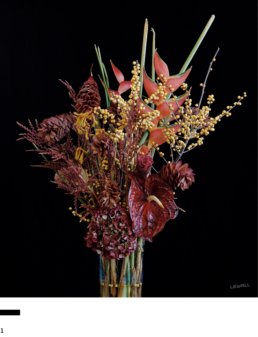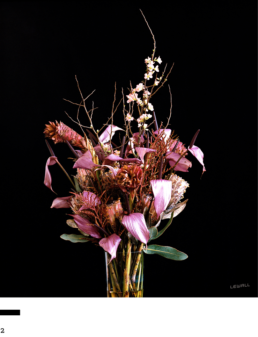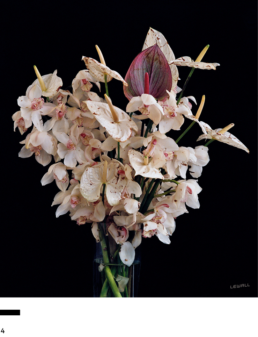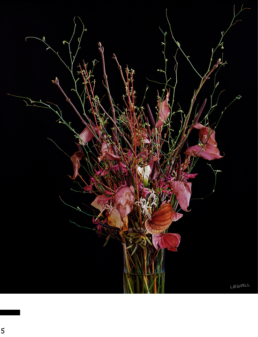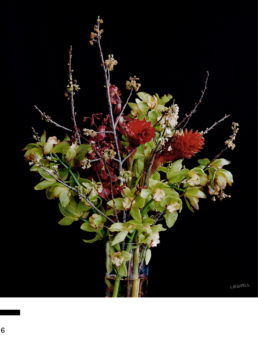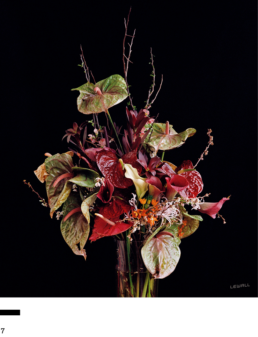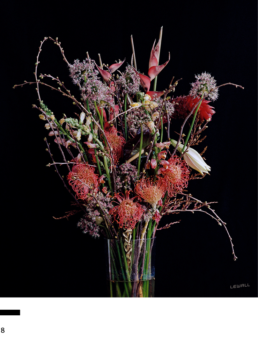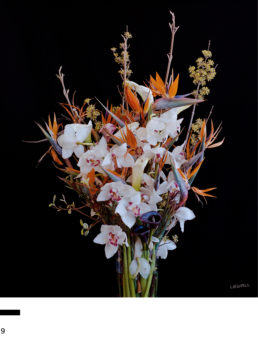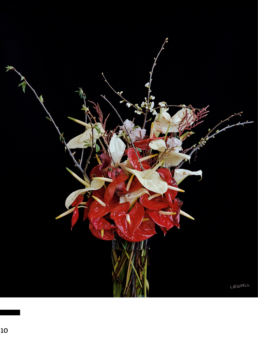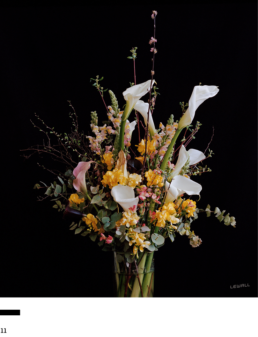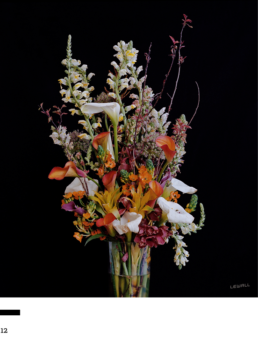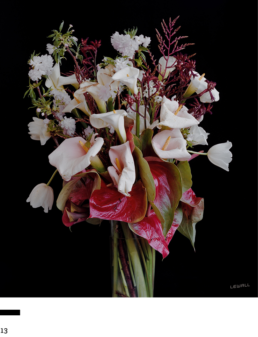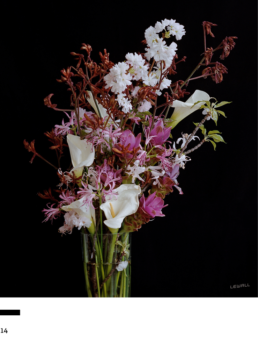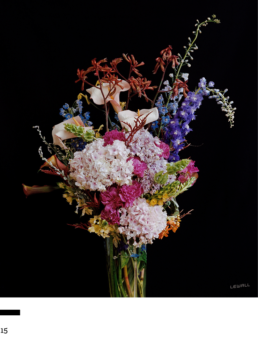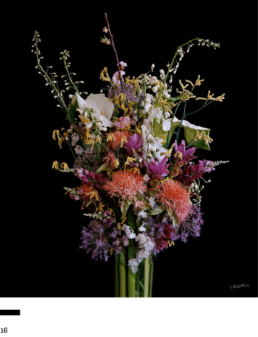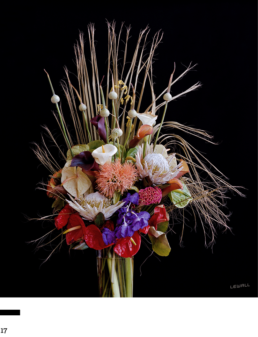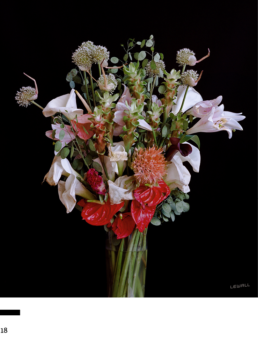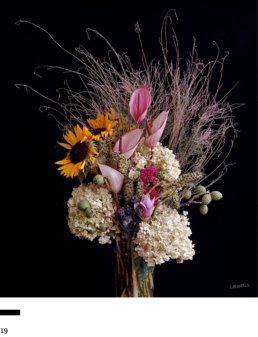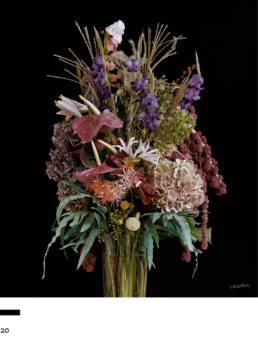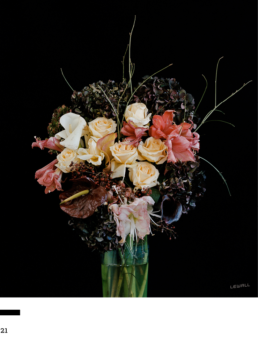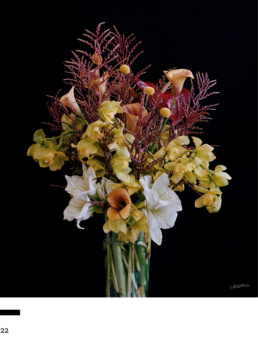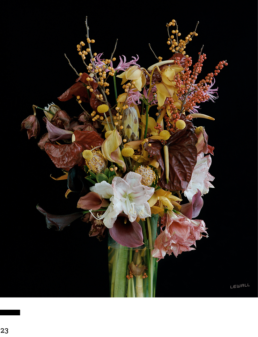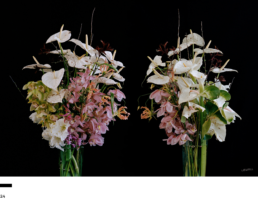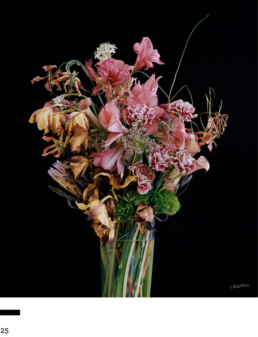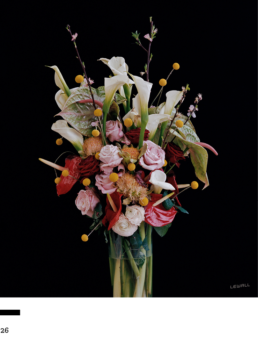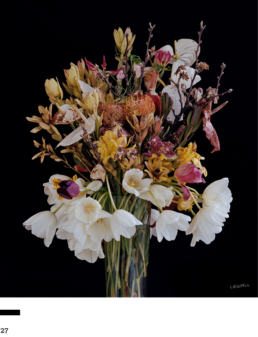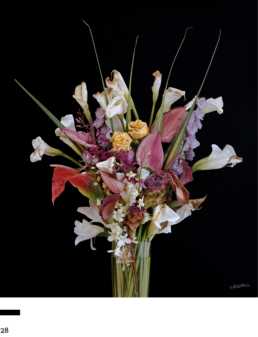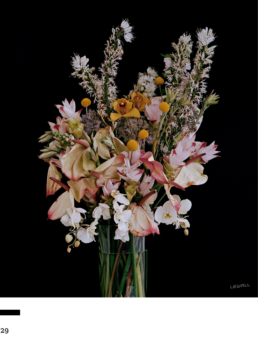Porträts eines biografischen Wandels
von Claudia Kaiser
In der vorliegenden Fotoserie „Living Twice“ manifestiert sich vieles, was Andreas Herangehensweise als Künstler und Mensch ausmacht. Denn schon seit jeher arrangiert und bearbeitet er auf die eine oder andere Weise ganzheitlich gesehen Materie zur Form. Entstanden als eine sehr persönliche Art des Protokollierens nach Therapie-Behandlungen, die herkömmlicherweise als Skriptum zur Erkenntnisvertiefung gemacht werden, verarbeitet er hier nach den jeweiligen Sitzungen im Mülleimer vor Ort gefundene Blumen und Pflanzen, die bereits verblüht und aussortiert wurden, zu opulenten Sträußen – zu epistemologischen Bouquets – innerer Bewusstseinsstadien, an welchen er uns durch sein Festhalten mit der Kamera teilhaben lässt. Die hyperrealistische Arbeit zeigt erst beim genauen Schauen, das sie uns abverlangt, Werden, Wachstum, Reifen, aber auch Rückzug, Absterben und Vergehen. Die Natur wird hier bewusst als Abbild ganz persönlicher psychischer Prozesse im Menschsein verwendet. Und so knüpft das hier vorliegende Blumenmotiv nicht an die Tradition des Vanitas-Stilllebens des Barocks und ihrem Verweis auf den Tod als Krönung an, sondern deutet auf die Sinnerfüllung im Leben im Hier und Jetzt im Verständnis einer fernöstlichen Philosophie. Das Konfrontieren mit der Vergänglichkeit führt zu Veränderung und seelischer Wandlung in der Gegenwart. Allem Neuen wohnt ein Gehen von Altem inne, denn die Auseinandersetzung mit dem Tod ist etwas Lebensstiftendes.
Aus therapeutischer Sicht ist diese florale Fotoserie als künstlerisches Ergebnis des Beschäftigens mit der eigenen Psyche, gleichsam dem Führen eines Tagebuchs auf einer visuellen Ebene, ungewöhnlich neu, aber in vielfacher Weise sinnvoll und für den philosophischen Kontext beeindruckend logisch: Die Natur als Anschauungsmaterial zu verwenden, deutet schon auf den Ursprung des Wortes „natura“, das im Griechischen dem Wort „physis“ entspricht, das sowohl den Prozess des Werdens, Wachsens, Blühens oder Aufgehens als auch die Beschaffenheit bzw. das Wesen von allem Lebendigen bedeutet. Dieses innere Wesen, die Natur alles Lebendigen – und daraus kann man folgen, eines Menschen – geht aus seiner Entstehung und seiner weiteren Entwicklung hervor. Gleichsam der Kunst des japanischen Ikebana schafft Andreas allein durch die Auswahl und das Arrangieren des Materials jenseits von dekorativer Form eine Harmonie von linearem Aufbau an Rhythmik und Farbe, die ordnet, um klar sehen zu können und Neues zum Vorschein zu bringen, er bearbeitet und resümiert, löst und verinnerlicht. Im Schöpfungsprozess wird der meditative Gedanke des ewigen Wandels nachvollzogen. Diese Bedeutung des Weges „Do“ stellt in vielen japanischen Ausdrucksformen eine Tradition dar, ohne die Kunst nicht existieren kann.
So wie beim Zen-Buddhismus die Erleuchtung nur durch intuitive Erfahrung erlangt werden kann, so ist es auch beim Streben nach Meisterschaft in der jeweiligen Kunst notwendig, der eigenen schöpferischen Freiheit beim Praktizieren keinen Raum zu geben. Hier bricht Andreas mit der fernöstlichen Kultur und es reicht ihm nicht, die Blumenarrangements als Ergebnis seines Weges eines psychologischen Wandels in Form eines abermals vergänglichen dreidimensionalen Objekts zu belassen, sondern er bedient sich des zeitgenössischen Mediums der Fotografie, um im Zweidimensionalen ein Abbild vom Abbild als weitere Manifestation zu schaffen.
So wird erst durch das bewusste Festhalten und Ablichten der arrangierten Motive rein formal der ganzheitliche Arbeitskomplex zum Kunstwerk im westlich tradierten Sinn. In seiner eigenständigen, optischen Erfahrbarkeit ganz losgelöst von jeglicher psychologischer Bedeutung und kulturwissenschaftlicher Zuschreibung entfaltet jedes einzelne Bild der Serie in seiner bestechenden Präzision eine so auratische Wirkung im Jetzt, in dem es einen zurückgelegten Weg sichtbar macht. In ganzer Pracht.
Portraits of a biographical transformation
by Claudia Kaiser
Translation: Eva Fürthauer
The photo series „Living Twice“ attests to several features that characterise Andreas‘ approach, both as an artist and as a human being. When looking at the entirety of Andreas’s work, he has always been doing in one way or another is arranging and processing material into form.
The work could be considered a highly unique note-taking method after counselling sessions, which traditionally takes the form of written documentation to consolidate the lessons learned. What Andreas does here, however, taking withered and discarded flowers and plants found after therapy sessions in the trash bin outside. These he reshapes them into lavish floral arrangements – epistemological bouquets, as it were – of internal states of consciousness, which he allows us to share by capturing them with his camera. Only with the close observation the artist demands of us is that this optically realistic work shows becoming, growing, maturing, but likewise withdrawal, death and decay. Here, nature is deliberately used to depict highly personal psychological processes that are part of the human condition. Thus the floral motif we see here draws not upon the Baroque tradition of the Vanitas still life and its intimation of death as the apotheosis, but instead points to the fulfilment of the meaning of life in the here and now, as it is understood in Far Eastern philosophy. This confrontation with the ephemerality of existence gives rise to change and spiritual transformation in the present. Embracing the new always implies an inherent letting go of the old, because facing death is a life-affirming act.
From the therapeutic point of view, this floral photo series, being the artistic outcome of the artist’s exploration of his psyche, is akin to a kind of visual diary: new and unusual, but in many ways meaningful and – given the philosophical context – strikingly logical. Indeed, this way of using nature as illustrative material points to the very origin of the word „natura“, which corresponds to the Greek word „physis“, meaning both the process of becoming, growing, blossoming or realisation as well as the constitution or essence of all life. This inner being, the nature of all living things – and, thus follows, of a human being – emerges from its genesis and further evolution, similar to the Japanese art of ikebana, Andreas – purely through the choice arrangement the materials move beyond decorative form. Creating harmony through the linear composition of rhythm and colour; a balance which brings order, allowing us a clear view that brings new aspects to light; which processes and summarises, dissolves and internalises.
The meditative contemplation of eternal transformation is re-enacted in the creative process. In many forms of Japanese artistic expression, the importance of this „do“ („way“) represents a tradition without which art cannot exist.
Just as in Zen Buddhism, where enlightenment can only be attained through intuitive insight, in striving for mastery in the respective art form it is likewise necessary to allow oneself no scope for creative freedom in the practice of one’s art.
In this respect Andreas breaks with Far Eastern culture: for him, it is not enough to leave the flower arrangements, the outcome of his journey of psychological transformation, in the form of another ephemeral three-dimensional object; instead, he uses the contemporary medium of photography to create an image of the image as a further manifestation in the two-dimensional plane. Thus the complex of work in its entirety only becomes a work of art in the traditional Western sense through the conscious photographic capture of the respectively arranged motifs.
They are entirely divorced from any psychological meaning in its independent validation of two-dimensional visual tangibility. The images go far beyond the relationship of lines, masses, colours and forms in a purely formal sense. Thus going beyond classification in terms of art history, in its precision it exudes such an auratic effect in the here and now through its covert reference to a path travelled, in all its glory.

